
A History of and Guide to
UNIFORM EDITIONS OF MARK TWAIN'S WORKS
"Remembering that the book 'How to Tell a Story' was
too small, I sent Bliss a list of recent magazine articles with the idea that
they should be added to that book to make it large enough."
- Samuel Clemens to Henry H. Rogers, 1 October 1898
Chapter 24
Brief Overview of Volume 22:
How to Tell a Story and Other Essays (1900)
Retitled
Literary Essays (1917)
First Publications
In April 1897 Harper and Brothers published a collection of
eight Mark Twain essays in a small volume titled How to Tell a Story.
Seven of the eight had been previously published in various magazines. The
title piece "How to Tell a Story" first appeared in the October
3, 1895 issue of Youth's Companion. Other essays in the collection
were originally published in The North American Review including
"Private History of the 'Jumping Frog' Story" (April 1894); "In
Defence of Harriet Shelley" (July through September 1894); "What
Paul Bourget Thinks of Us" (January 1895); and "Fenimore Cooper's
Literary Offences" (July 1895). "Travelling with a Reformer"
from Cosmopolitan, December 1893 is included in the collection although
the original illustrations by Daniel Carter Beard for the story were dropped.
Also included is "Mental Telegraphy Again" from September 1895
Harper's Monthly. The only previously unpublished essay in this first
edition is "A Little Note to M. Paul Bourget" which was Clemens's
response to criticism he had received after publishing his first Paul Bourget
article in 1895.
In April 1900 at the same time Frank Bliss was compiling Volume
22 of the uniform edition of American Publishing Company, Harper was also
in the process of adding another collection of short stories to their uniform
trade editions that were bound in red
cloth with gold cornstalks. Their latest edition was titled The Man
That Corrupted Hadleyburg and Other Stories and Essays which was published
June 11, 1900.
Compiling Volume 22
Frank Bliss used Harper's How to Tell a Story and Other Essays as the
foundation for Volume 22 of American Publishing Company's uniform edition of
Mark Twain's works. Volume 22 was copyrighted on April 9, 1900. To bulk up the
original slim collection of eight essays, Bliss added eight additional essays,
some of them had also been selected for inclusion in Harper's 1900 edition of
The Man That Corrupted Hadleyburg and Other Stories and Essays.
Bliss included "The Invalid's Story" which was actually part of a
longer essay titled "Some Rambling Notes of an Idle Excursion." "The
Invalid's Story" had been deleted from the longer story when it was first
serialized in Atlantic Monthly in 1877-78. However, Clemens liked "The
Invalid's Story" and had restored it when "Some Rambling Notes of
an Idle Excursion" appeared in the collection The Stolen White Elephant,
Etc. published by James R. Osgood in 1882. Harper and Brothers, however,
had again deleted "The Invalid's Story" from the longer essay when
they included "Some Rambling Notes of an Idle Excursion" in the 1896
edition of Tom Sawyer Abroad / Tom Sawyer Detective and Other Stories.
Bliss followed Harper's lead when he compiled Volume 20 of the 1899 uniform
edition, Tom Sawyer Abroad / Tom Sawyer Detective and Other Stories, Etc.,
Etc. With Volume 22 Bliss had the opportunity to use "The Invalid's
Story" as a standalone essay.
Bliss was likely confused about what essays had been included in the previous
volumes. "The Captain's Story" which is another portion of "Some
Rambling Notes of an Idle Excursion" is also included as a standalone essay
in Volume 22. However, this essay is intact in Volume 20, Tom Sawyer Abroad
/ Tom Sawyer Detective and Other Stories, Etc., Etc. Part of Bliss's confusion
may have resulted from the fact that in 1892 Clemens's own Webster and Company
had published both "The Invalid's Story" and "The Captain's Story"
(from the longer "Some Rambling Notes of an Idle Excursion" ) as two
standalone essays in the slim volume titled Merry Tales. Thus, in spite
of his best efforts to avoid duplication of material, "The Captain's Story"
is a duplicate essay and the text of it appears in two separate volumes of the
1899 uniform edition from American Publishing Company, in Volumes 20 and 22.
The 1900 edition of Volume 22 also features "In Memoriam," Clemens's
tribute to his dead daughter Susy which was first published in November 1897
Harper's Monthly. Appearing in a collection for the first time are "Stirring
Time in Austria" from the March 1898 issue of Harper's Monthly;
"Concerning the Jews" from the September 1899 issue of Harper's
Monthly; "From the 'London Times' of 1904" from November 1898
Century magazine; and "At the Appetite-Cure" from August 1898
Cosmopolitan. The final essay in Volume 22 is Samuel Moffett's biographical
essay about his uncle, reworked from Clemens's own draft, titled "Mark
Twain: A Biographical Sketch." Moffett's essay first appeared in the October
1899 issue of McClure's Magazine and was accompanied by a footnote
containing a puff for American Publishing Company's uniform edition of Mark
Twain's works.
Refining the Work
Although Clemens had an opportunity to revise and refine his
work for the uniform edition, there is little evidence to suggest he took
an active interest in doing so. Production of the new printing plates also
had the potential to introduce inconsistencies into the texts that were
the result of typesetting errors. However, no extensive comparison between
Volume 22 and the previous printings of each essay has been conducted.
|
Frank Bliss intended to correct any errors for subsequent printings
and hired Forrest Morgan (b. 1852 - d. 1924), a fastidious proofreader,
to weed out errors. Morgan, a former editor of the Hartford Travelers
Record and later an assistant librarian at Watkinson Library in
Hartford, read from a set of the Royal
Edition to mark errors.
Clemens was familiar with the work of Forrest Morgan in Travelers
Record. When Clemens wrote "Stirring Times in Austria"
in 1897 he quoted from a long passage he credited to Morgan to describe
the history of disunity in the Austro-Hungarian empire. "Stirring
Times in Austria" was published in Harper's Monthly in
March 1898 and is reprinted in Volume 22.
Morgan's 22-volume set of the Royal Edition with his annotations
is in the Beinecke Rare Book and Manuscript Library at Yale University,
a gift from William Lyon Phelps in 1922.
|
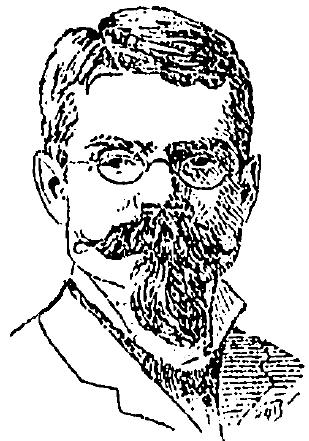
Forrest
Morgan, proofreader for the 1899 uniform edition, helped refine the
works for subsequent editions. |
Different Title on the Spine
Instead of using the book's title How to Tell a Story and
Other Essays on the spine of Volume 22, Bliss chose to identify the
book as Volume XXII / Literary Essays, Etc. This designation appears
on all the uniform editions published by American Publishing Company including
Autograph Edition, Edition
De Luxe, Japan Edition, Author's
De Luxe Edition, Royal
Edition, Underwood Edition, Riverdale
Edition and Hillcrest
Editions.
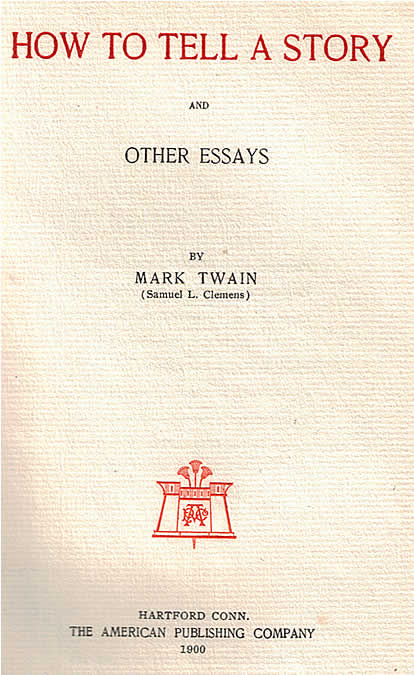
Secondary
title page for Volume 22 reads
How to Tell a Story and Other Essays |

Spines
for Volume 22 read Literary Essays |
W. H. W. Bicknell's Contributions
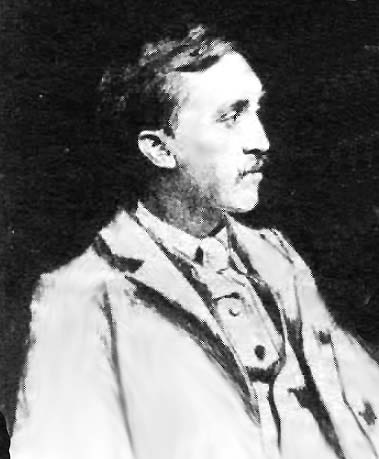
William
Harry Warren Bicknell
photo courtesy of the Winchester, Massachusetts Archival Center |
Frank Bliss hired new illustrators for the 1899 uniform edition.
Artist and etcher William Harry Warren Bicknell (b. 1860 - d. 1947)
was born in Boston, Massachusetts, the son of a grocer. Bicknell graduated
from the Boston Latin School in 1878 and later studied at the Boston
Museum of Fine Arts. He was a pupil of Otto Grundmann and Frederic
Crowningshield. Bicknell etched a number of frontispieces made from
photographs of Clemens that were used throughout the set. Bicknell's
etching of the Tiffany monogram appears as a title page in every volume
of the Autograph Edition,
Edition De Luxe, Japan
Edition, Author's
De Luxe Edition, and the Royal
Edition. All of these editions began issuing in 1899.
Less expensive editions such as Underwood,
Riverdale, and
Hillcrest feature the Tiffany title
page in Volume 1 only. It was eliminated altogether from the Author's
National Edition.
|
Frontispiece by Elson of Boston
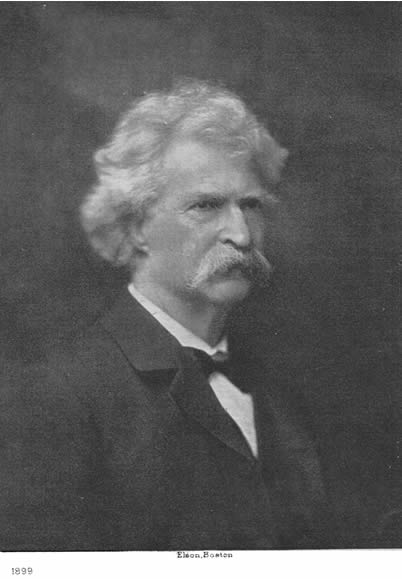
Frontispiece
for Volume 22 |
Volume 22 is the first volume in American Publishing Company's uniform
editions that does not feature an engraved frontispiece portrait of
Clemens credited to W. H. W. Bicknell. The frontispiece portrait for
Volume 22 is based on a photograph of Clemens taken in 1899 by H. W.
Barnett in London. It was etched by the Alfred Walter Elson Company
of Boston. |
Charles Dater Weldon, Illustrator
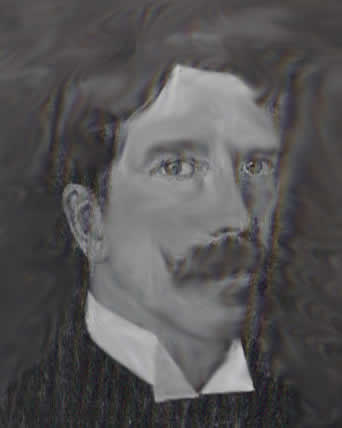
Charles
Dater Weldon |
Charles Dater Weldon (b. 1844 - d. 1935) was born in Mansfield, Ohio.
He is listed in both the 1850 and 1860 U. S. censuses as the son of
James Weldon, a successful merchant and his wife Isabell. Weldon's early
education was at the Cleveland Institute, a military academy. At age
eighteen he moved to Philadelphia and worked for a financial firm. He
then spent a year at Iowa City managing a hat and fur store. His first
work in the art profession as a lithographer was in Chicago. He later
went to New York and worked as an illustrator for the New York Daily
Graphic. For a short while he studied abroad at Leigh's Academy
in London before returning to his job at the Daily Graphic. On
a second sojourn abroad to Paris in 1880 he studied under Mihály
Munkácsy where he spent two years. Weldon was commissioned by
Harper and Brothers to go to Japan in the early 1890s and he spent five
years there. He also spent time in China and India and became known
as a specialist in oriental motifs. Weldon was a member of the National
Academy of Design, the American Watercolor Society and the Century Club. |
Weldon provided two illustrations for Volume 22 -- one for "Travelling
with a Reformer" and a second for "The Invalid's Story."
Weldon's illustration for "Travelling with a Reformer" features
the same scene that Daniel Carter Beard drew for the story when it first
appeared in Cosmopolitan magazine in December 1893.
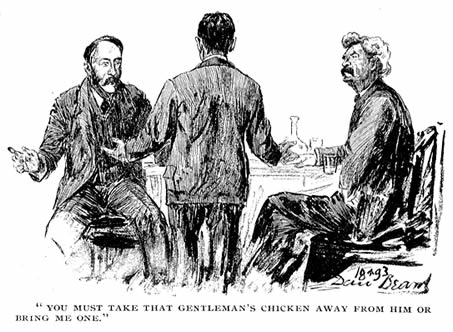
Daniel Carter Beard's original illustration from
Cosmopolitan, December 1893. |
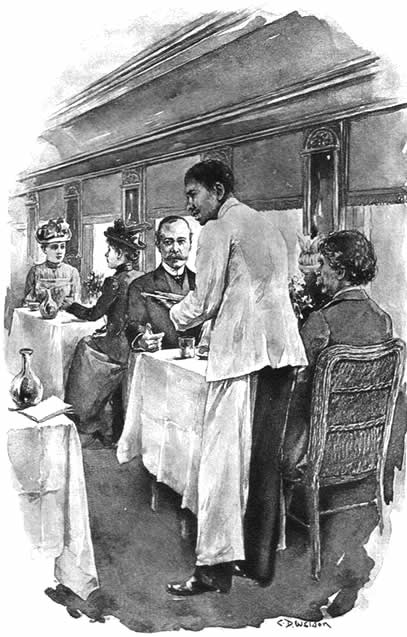
Charles
D. Weldon's illustration from Vol. 22 is titled
"That Gentleman Has Chicken" |
Peter Newell, Illustrator
|
Peter S. Newell (b. 1862 - d. 1924) was born in McDonough County,
Illinois, the son of Fred Newell, a wagonmaker. As a youngster, he
attended schools in Bushnell, Illinois. He later went to New York
and attended the Art Students League for a short time, but he was
largely a self-taught artist. He did most of his professional work
for Harper and Brothers. He had worked for Frank Bliss previously
when he provided five pictures for the first American edition of Following
the Equator (1897). Bliss also hired Newell to furnish six new
full-page illustrations for the 1899 uniform edition of The
Innocents Abroad.
For Volume 22, Frank Bliss chose to reuse one of Newell's original
illustrations for "At the Appetite Cure" that was used when
the story was published in Cosmopolitan magazine in August
1898.
|
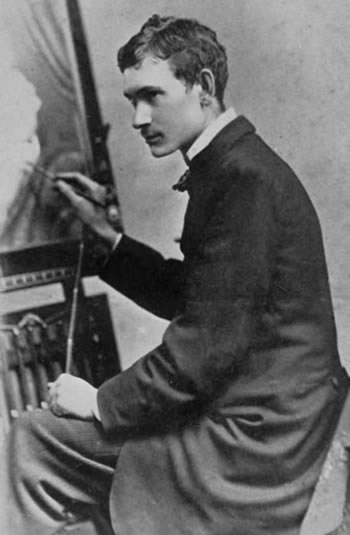 Peter
S. Newell
Peter
S. Newell |
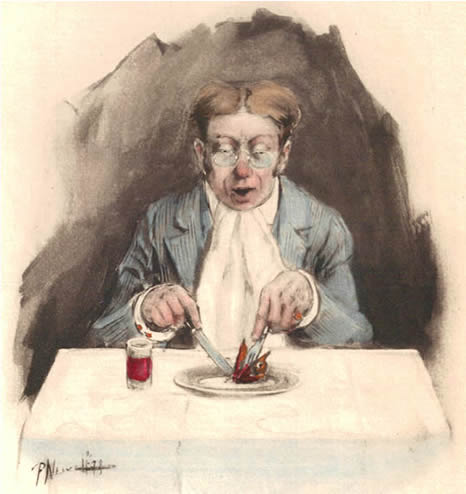
Newell's illustration
from Cosmopolitan, August 1898 titled
"He Eats a Butterfly" was hand-colored and used as a frontispiece
for Volume 22 of the 1901 Riverdale
Edition.
-
PORTRAIT, 1898 - (by permission of H. W. Barnett, London,
frontispiece)
-
TITLE - designed by Tiffany and Co.- (etched by W. H.
W. Bicknell)
- "THAT GENTLEMAN HAS CHICKEN" - (Charles Dater Weldon)
-
THESE GAVE IT A BETTER HOLD - (Charles Dater Weldon)
- HE EATS A BUTTERFLY - (Peter Newell)
Harper and Brothers Revises the Contents
From 1899 until mid-1917 the contents of Volume 22 of the
uniform edition of Mark Twain's works, How to Tell a Story and Other
Essays, remained the same. In mid-1917, long after Harper and Brothers
had taken over production of the uniform editions begun by American Publishing
Company, they revised the contents for Volume 22 for a new printing of the
Author's National Edition. Harper removed
a number of selections including "How to Tell a Story" and retitled
the volume Literary Essays which matched the title on the spine.
Essays that had originally appeared in Volume 21 were moved to Volume 22.
This reshuffling of material is one source of confusion for book collectors
who often try to acquire replacement volumes for incomplete sets. The task
is further complicated due to the fact that the bindings for a number of
years were extremely similar even though the contents were different.

Harper
edition of Vol. 22, How to Tell a Story with spine title Literary
Essays and printing date of M-Q (December 1916) retains the original
1900 table of contents. |

Harper
edition of Vol. 22, retitled Literary Essays on both title page
and spine with printing date of I-T (September 1919) features slightly
smaller binding and Arabic volume numbers 22 on the spine and slightly
different contents. |
For the mid-1917 Author's National Edition, Harper and Brothers removed
stories from Volume 21 that had been reprinted from the first edition of
The £1,000,000 Bank-Note and Other New Stories and moved them
to Volume 22. The previous title story "How to Tell a Story" was
deleted and "In Defence of Harriet Shelley" became the lead story.
In later uniform editions the volume would be retitled In Defense of
Harriet Shelley.
The following table details the shifting contents of
Volume 22.
Titles in bold are those that are unique to the particular
volume in comparison to the others..
|
ORIGINAL FIRST EDITIONS
|
Table of Contents for Vol. 22
American Publishing Company 1900 Uniform Editions and Harper's editions
through mid-1917
|
Table of Contents for Vol. 22
Harper's Author's National Edition after mid-1917
|
How to Tell a Story and Other Essays (Harper and
Brothers, 1897)
(unillustrated)
-
How to Tell a Story
-
In Defence of Harriet Shelley
-
Fenimore Cooper's Literary Offences
-
Travelling with a Reformer
-
Private History of the "Jumping Frog Story"
-
Mental Telegraphy Again
-
What Paul Bourget Thinks of Us
-
A Little Note to M. Paul Bourget
____
The Man That Corrupted Hadleyburg and Other
Stories and Essays
(Harper and Brothers, 1900)
- The Man That Corrupted Hadleyburg
- My Début as a Literary Person
- From the "London Times" of 1904
- At the Appetite-Cure
- My First Lie, and How I Got Out of It
- Is He Living or Is He Dead?
- The Esquimau Maiden's Romance
- How to Tell a Story
- About Play-Acting
- Concerning the Jews
- Stirring Times in Austria
- The Austrian Edison Keeping School Again
- Travelling with a Reformer
- Private History of the "Jumping Frog" Story
- My Boyhood Dreams
|
How to Tell a Story and Other Essays on
title page with
Literary Essays on spine
- How to Tell a Story
- In Defence of Harriet Shelley
- Fenimore Cooper's Literary Offences
- Travelling with a Reformer
-
Private History of the "Jumping Frog Story"
-
Mental Telegraphy Again
-
What Paul Bourget Thinks of Us
-
A Little Note to M. Paul Bourget
- The Invalid's Story
- The Captain's Story
- Stirring Times in Austria *
- Concerning the Jews *
- From the "London Times" of 1904 *
- At the Appetite Cure *
- In Memoriam *
- Mark Twain: A Biographical Sketch *
_____
* First collected appearance
|
Retitled Literary Essays
on title page
with Literary Essays on spine
- In Defence of Harriet Shelley
- Fenimore Cooper's Literary Offences
- Travelling with a Reformer
-
Private History of the "Jumping Frog Story"
- Mental Telegraphy
-
Mental Telegraphy Again
-
What Paul Bourget Thinks of Us
-
A Little Note to M. Paul Bourget
- The Invalid's Story
- Stirring Times in Austria
- The German Chicago (from pre-1917 Vol.
21)
- Concerning the Jews
- About All Kinds of Ships (from pre-1917 Vol.
21)
- From the "London Times" of 1904
- A Majestic Literary Fossil (from pre-1917 Vol.
21)
- At the Appetite Cure
- Saint Joan of Arc (from pre-1917 Vol.
24)
- In Memoriam
- Mark Twain: A Biographical Sketch
|
_____
References
Blanck,
Jacob, compiler. Bibliography of American Literature, Volume Two. (Yale
University Press, 1957).
"C.
D. Weldon, Painter, Dead at 80," The New York Times, 10 August
1935, p. 13.
Dearinger,
David B., ed. Paintings and Sculpture in the Collection of the National
Academy of Design. (The National Academy of Design, 2004). Online at google
books.
Johnson,
Merle. A Bibliography of the Works of Mark Twain. (Harper and Brothers,
1935).
Leary,
Lewis, ed. Mark Twain's Correspondence with Henry Huttleston Rogers 1893-1909.
(University of California Press, 1969).
Rasmussen,
R. Kent. Critical
Companion to Mark Twain, Volumes I and II. (Facts on File, 2007).
Schroeder,
Edwin C. Personal correspondence, 31 August 2010.
Twain,
Mark. How to Tell a Story and Other Essays, Volume 22, Japan Edition.
(American Publishing Company, 1900).
_____.
How to Tell a Story and Other Essays. (Oxford University Press, 1996).













